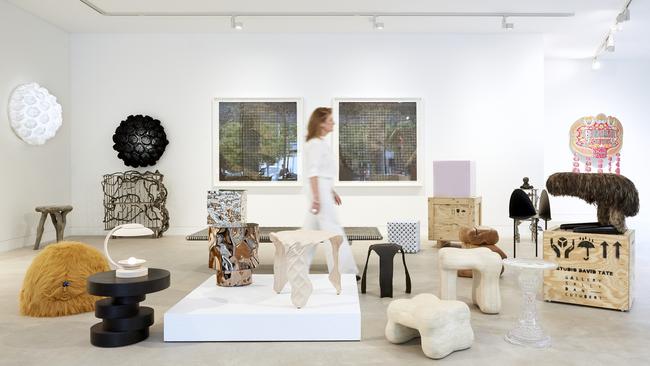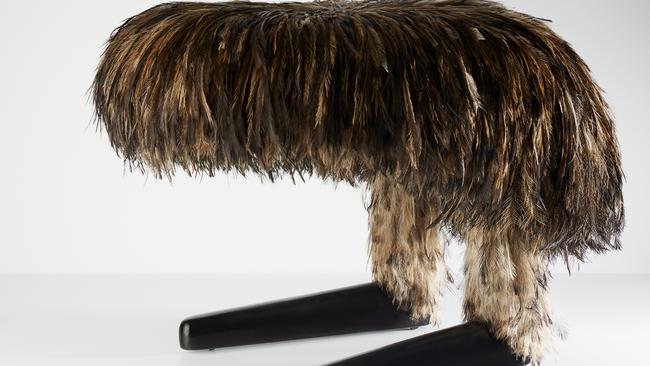Art you can live with
Sydney gallerist Sally Dan-Cuthbert says ‘collectible design’ can straddle form function.

It’s an odd feeling walking into Gallery Sally Dan-Cuthbert, in Sydney’s Rushcutters Bay. In contrast to your standard gallery space, here you’re actually allowed – encouraged even – to touch the art. Or collectible design, as the eponymous art consultant-turned-gallerist also describes the work she deals in.
“We say functional art, because we are the first gallery in Australia that provides a permanent space to artists in the functional art or collectible design sphere,” explains Dan-Cuthbert. “It just seemed to make sense, because calling it functional art was distinguishing it from design, or a chair for just a chair’s sake. That’s not what we do.”
So when is a chair not purely a chair? Dan-Cuthbert says it’s simple: “When an artist has spent time conceiving and making it.” Straddling the liminal demarcation between fine art and everyday objects, collectible design – functional art – refers to objects that combine aesthetic value with utilitarian elements. Where traditional art requires an intellectual or emotional approach for consideration, collectible design brings a sense of purpose to the finished product. It is, to be simplistic, art that’s been designed to live your life in.

“When you’re looking at a painting, obviously you can study it and there are techniques for looking at it, but you actually have a tactile experience with a piece of design,” explains Dan-Cuthbert. “When you look at, and sit on, a chair, a stool or a bench, you can actually engage and become one with it. You really can feel and notice the details of that piece. Why wouldn’t I want the chair or tables inside my home to be as important as the paintings on my wall?”
As she gestures towards the table inside the showroom, it’s impossible not to share Dan-Cuthbert’s enthusiasm and passion as she extols the table’s virtues. “This has been made using one of the rarest woods in the world – it’s been carbon dated to more than 10,000 years before the last Ice Age,” she says. “It’s the only known black timber in the world – it’s not stained, it’s naturally this colour. This is why I commissioned this artist to do it for the gallery, so when you come in here and we sit and have a meeting, you’re starting to already understand [what we are doing]. It’s silky smooth – look at the light hitting it. It’s absolutely unbelievable.”
‘We represent artists who work uniquely, or in small editions’
Specialising in Australian artists and designers, Dan-Cuthbert launched the gallery in 2019 to offer a platform for the extraordinary and unique work being made locally, and dispel the myth that we had to look overseas for quality, hand-made design that could potentially have the same investment value as an artwork. Work such as the leather-bound Ngumu Janka Warnti chair made by Trent Jansen and Indigenous artist Johnny Nargoodah using repurposed materials and leather sourced from New Zealand (chosen for its exceptional softness). The soft, fluid lines that mark its silhouette contrast with its inherent sturdiness. At first glance it’s more sculpture or even statue than a chair, yet the sensuality of the piece still beckons the observer to literally take a seat.

Another piece, a light sculpture by Pakistani born Abdullah M.I. Syed called Aura I made entirely from black or white topis – hand-crocheted caps worn by Muslim men during prayer – does the seemingly impossible: it turns light textural. Filtered through the intricate patterns of the caps, it creates a moon-like surface that’s illuminated from within.
Dan-Cuthbert also explains that, as with artworks, what distinguishes the artists and designers she represents from more familiar names is that there is often only one of their items, or it has been made in extremely limited numbers. “We represent artists who work uniquely, or in small editions” she says. “Of course you can have design items that are design icons and collectible, but they’re mass produced. What I’m trying to do is be anti mass production.”
She admits that while other sectors of the arts suffered during COVID-19, people having to stay home and interact with their surroundings helped catapult her through the early days of the gallery. “People were in their homes and in their apartments and actually looking around them,” she says, “spending a genuine amount of time there, probably for the first time in a long time. So all of a sudden you realise that chair you’ve been sitting on is actually really uncomfortable. It was fine for two seconds when I just picked it up without thinking, saying ‘I like the look of that; it’s okay’. But when you actually had to spend time with it you started to learn the difference between good design and just design. Or collectible design and design.”



To join the conversation, please log in. Don't have an account? Register
Join the conversation, you are commenting as Logout